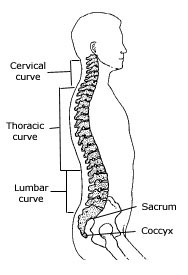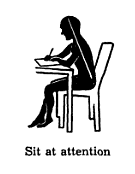They are the battle cries of moms and elementary school teachers all over the world: “Sit up straight!” and “Stop slouching!” Despite what our third grade minds may have thought, sitting up straight wasn’t a stress position used to break unruly children. Believe it or not, our parents and teachers had a reason for issuing these demands. They intuitively knew of the health and psychological benefits people with proper posture enjoyed, and they were just trying instill the habit into our young, impressionable minds. To their disappointment, we probably ignored them and went on with our slouching ways.
But today we’re going to redeem ourselves. Today we’re going to improve our posture.
The Benefits of Good Posture
There are several ways that good posture can improve both mind and body. Below we list a few of them:
Improves organ function. When we’re slouched forward, our rib cage is actually pushing down on our internal organs. All this mushing can cause digestive problems. By having good posture, we keep things nice and open for our intestines to do their work.
Reduces tension and pain in neck, shoulders, and back. If you suffer from chronic pain in your upper body, it may be caused by your poor posture. When you first start practicing good posture, you may feel as though you had less pain and tension when you slouched around all day. But keep at it. You’re retraining your body to have the posture nature intended. After a week of strengthening muscles you probably haven’t worked in awhile, your chronic pain should begin to dissipate.
Increases concentration and mental performance. A study done by Colorado College showed that male students with the best sitting posture scored significantly higher on tests than students who slouched. Tomi Ann Roberts Ph.D, lead study author, stated that “an upright posture makes people feel dominant and successful, which in turn improves their ability to relax and focus on problems.” Interestingly, the study showed that only male students benefited academically from improved posture. Good posture didn’t seem to have an affect on women.
Prevents humped shoulders. We often only associate the shoulder hump with little old ladies and Quasimodo. But men can develop a “dowager’s hump,” too. The hump develops through a combination of bad posture and osteoporosis. Osteoporosis is common in older women, but men can also see a significant loss of bone mass as they age. You can help stave off the hump by focusing on maintaining good posture throughout your life (and taking a calcium supplement when you get older).
Increases height. Studies have shown that taller men earn more money and attract more women than their shorter counterparts. That’s not to say if you’re shorter, you can’t make lots of money and be a lady killer. I mean, look at Tom Cruise. But these studies suggest height is one of the evolutionary factors that we take into account when we size people up. But before you go out and buy some lifts, consider the fact that many men are walking around 1 inch shorter than they actually are due to poor posture. While sitting up straight won’t turn you into LeBron James, it will at least maximize your God-given height.
Moreover, maintaining good posture while you’re young can help mitigate the height shrinkage that occurs in many elderly people. Allowing you to see over the wheel of your Cadillac well into old age.
Prevents “beer belly.” Have you ever seen those old men who have super skinny legs and arms, but then a small or sometimes huge beer belly? Well, there’s two factors at play here. First, as we age, our metabolism slows down, and as men, we store more fat in our bellies. This factor can be mitigated by proper diet and exercise. The other factor is- you guessed it- posture. As mentioned above, bad posture causes your rib cage to push down on your organs. Your organs are surprisingly malleable and will consequently protrude out and push against our abdominal wall. We see the effects of this pushing in our little Buddha Bellies. By standing and sitting up straight, we can help mitigate our beer bellies. You can truly take some inches off your waist just by practicing good posture. Beats doing sit-ups. Just kidding. But seriously. I hate sit-ups.
Increased confidence. Remember that Colorado College study we mentioned above? It also said that improved posture increases confidence in men. So next time you’re about to go into a job interview or are about to talk to a woman for the first time, stand up a little straighter to increase your manly swagger.
What Is Good Posture?
 Contrary to your third grade teacher, good posture does not require you to look like a stiff piece of board. Good posture involves having a relaxed appearance and a “neutral spine.” A neutral spine retains three natural curves: a small hollow at the base of the neck, a small roundness at the middle back, and a small hollow in the lower back. Many people overcompensate for bad posture by standing too straight, thus eliminating the natural curves of the spine.
Contrary to your third grade teacher, good posture does not require you to look like a stiff piece of board. Good posture involves having a relaxed appearance and a “neutral spine.” A neutral spine retains three natural curves: a small hollow at the base of the neck, a small roundness at the middle back, and a small hollow in the lower back. Many people overcompensate for bad posture by standing too straight, thus eliminating the natural curves of the spine.
When our posture is correct, the ears, shoulders, hips, knees, and ankles should align in one straight line. To give you a mental image of what good posture looks like, imagine hanging a plumb line from your earlobe. If your posture is correct, the line would hang straight to the middle of the anklebone.
If you’re not a mental imagery kind of guy, perform this “wall test.” Stand with head, shoulders, and back against the wall and your heels about 5-6 inches forward. Draw in the lower abdominal muscles, decreasing the arch in your lower back. Push away from the wall and try to maintain this upright, vertical alignment. That’s good posture.
Posture While Standing

1. Feet should be shoulder width apart, thigh muscles elongated without locking the knees back. Maintain most of your weight on the balls of your feet and not on your heels. When you put your weight on your heels, you create misalignment with your body. A quick test to see if your weight is properly distributed is to have someone gently push on your sternum. If you lose balance easily, then your weight is on your heels. Now try putting more of your weight on the balls of your feet and have someone push you again. You’re probably more stable this time because your body is better aligned.
2. Maintain a small hollow in your lower back, but avoid the tendency for too much arching or leaning back, especially with prolonged standing. The “tail” should remain slightly tucked down.
3. Lift your chest. Your shoulder blades should move down and back. This will create a good distance from your hip bone to your rib cage.
4. Make your chin level. The highest point of your body should be the top back region of your head. Relax your jaw and neck muscles.
5. Perform the wall test if needed to ensure your posture is good.
Posture While Sitting at a Desk

1. Feet should be resting on the floor with knees and hips bent 90 degrees. While it may seem more comfortable to cross our feet, this actually screws up our body’s alignment and causes unneeded stress on joints and muscles.
2. Maintain an arch in the lower back. If you are unsure how much arch is “good,” go from a slouched position up to the extreme end range of erect posture. Now back off 10-15%. This is the neutral position for your lower back.
3. Lift your chest. Picture a string tied to the 2nd or 3rd top button on a shirt pulling straight up to the ceiling.
4. Make your chin level. If it helps, picture a book on your head. The highest point of your body should be the top back region of your head.
5. Avoid slouching or leaning forward, especially when tired from sitting in the office chair for long periods.
6. Take frequent breaks. At first, trying to sit up straight in a chair can be tiring. After years of slouching, your body has probably created a new “bad” posture for itself, and it’s going to take some work to get it back to the way it should be. Take it slow from the beginning. Sit straight for 20 minutes and get up and take a break. Walk around, reach your hands towards the sky, and stretch. Sit down again and get back to work. Take another break 20 minutes later.
Keep Your Posture in Check
Maintaining good posture is definitely not easy. We can’t be thinking about it all the time. We may start off the day sitting upright, but a little while later, we’re lost in our work and slouching down. Here’s a easy way to remind yourself to work on your posture:
1. Tie one end of a string to the top button on your shirt.
2. Tie the other end of the string to your belt buckle, so that the string is taut when you’re sitting upright.
3. Whenever the string goes slack, you know you’re slouching. Sit up and restore your good posture.


